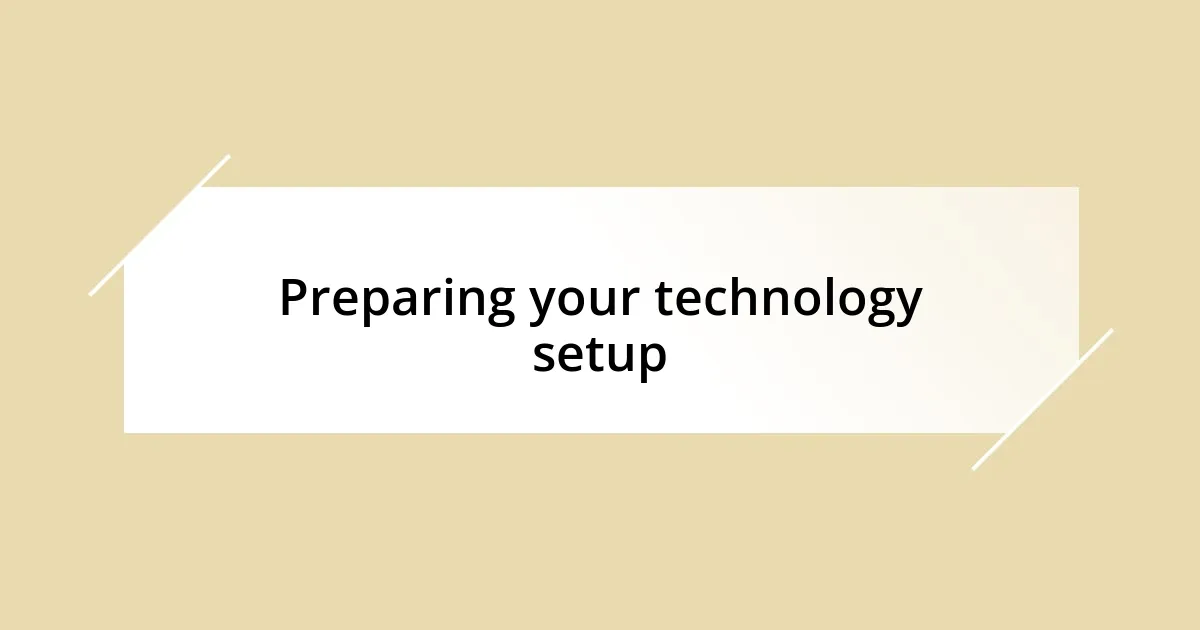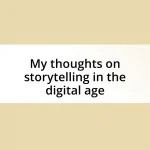Key takeaways:
- Ensure a reliable technology setup, including good internet, functional audio/video equipment, and a distraction-free environment for effective digital interviews.
- Master virtual body language by maintaining eye contact, using an open posture, and mirroring the interviewer’s cues to foster connection.
- Engage actively during the interview by listening attentively, asking insightful questions, and sharing relevant anecdotes that highlight your experiences.
- Follow up promptly with a personalized thank-you email to reinforce your enthusiasm and keep yourself memorable to the interviewer.

Understanding digital interviews
Digital interviews have transformed the way we connect with potential employers, making the process more accessible yet also more daunting. I remember my first digital interview vividly; sitting in front of the camera, I felt both excited and nervous as I tried to capture the same engaging energy I would have in person. Isn’t it fascinating how technology can create that mix of comfort and anxiety all at once?
One notable aspect is the importance of a good internet connection and a quiet environment, something I learned the hard way when my Wi-Fi decided to play hide-and-seek during a critical interview. Each glitch led me to realize how vital these elements are to present ourselves effectively. Have you considered how technical issues can impact your performance and confidence during a digital interview?
Additionally, understanding the nuances of virtual body language is crucial. I found that maintaining eye contact with the camera rather than the screen helped create a sense of connection, which is often lost in the digital realm. How do you convey enthusiasm and engagement when your interviewer is just a pixelated face? It’s all about being aware of these subtleties that can make or break the impression you leave.

Preparing your technology setup
It’s easy to overlook your technology setup when preparing for a digital interview, but I can’t stress enough how crucial it is. During one of my interviews, I was so focused on my responses that I forgot to double-check the sound settings. When the interviewer asked a question, I realized my microphone was muted! The embarrassment was palpable, and I learned to always test my hardware beforehand to avoid interruptions that can throw off your flow.
Beyond hardware, your software choices matter too. I once used a platform that glitched repeatedly, which made the interview feel disjointed. Now, I always opt for reliable software that I’m familiar with. Familiarity breeds confidence, which is something I value dearly in these high-stakes situations. Have you considered testing different platforms before deciding which ones work best for you?
Lastly, let’s not forget about your environment. One time, I didn’t account for background noise, and my cat decided it was the perfect moment to start meowing loudly. Not the professional backdrop I had envisioned! Ensuring a calm, distraction-free space can significantly enhance your presentation. An inviting backdrop with good lighting not only improves your visibility but can also make you feel more at ease.
| Element | Recommendation |
|---|---|
| Internet Connection | Wired connection preferred; test speed before interview |
| Microphone | Use a quality external mic; test audio levels in advance |
| Camera | Ensure good lighting; position at eye level for natural engagement |
| Software | Choose familiar and reliable platforms; practice using them |
| Background | Keep it clean and professional; minimize distractions |

Crafting your interview environment
Creating the right environment for a digital interview can feel like setting the stage for a performance. I can still recall the time I thought a cozy background would be charming, but as I prepared, I realized my cluttered bookshelf was the focal point. Instead of focusing on my qualifications, I worried about what the interviewer might see. It’s a simple reminder that your physical surroundings speak volumes about your professionalism and can impact the perception of your candidacy.
To ensure a successful interview environment, consider these elements:
- Lighting: Natural light can be your best friend—position your setup near a window to brighten your face.
- Noise Control: Use noise-canceling headphones or ensure you’re in a quiet space. I even put a sign on my door once to ward off interruptions from family.
- Background Setup: Choose a neutral background. A clean wall or simple artwork works well. I once used a busy mural and regretted it!
- Comfort: Set up in a comfortable chair and adjust your screen to eye level. The last thing you want is to be fidgeting because of discomfort.
- Tech Check: Run a technical rehearsal the day before to troubleshoot any last-minute issues. I caught a software update that would have derailed my big moment!
By crafting an inviting and professional interview environment, you set the tone for a confident and engaging conversation.

Mastering body language cues
Mastering body language cues can significantly elevate your digital interview performance. I remember an interview where I tried to convey confidence, but my crossed arms gave a completely different impression. It’s fascinating how something as subtle as a shift in posture can alter perceptions. Have you ever been in a situation where you felt confident but your body didn’t quite reflect that? I know I have, and it drove home the point that being aware of my non-verbal cues can make or break how I’m perceived.
It’s also essential to strike a balance between appearing engaged and relaxed. During a recent interview, I made a conscious effort to lean slightly forward, showing my interest, yet I also practiced maintaining an open posture. This mix felt natural and helped foster a connection with the interviewer, making the conversation flow more smoothly. Keeping your hands visible can also add to the openness of your body language; I’ve noticed that it creates a sense of honesty and receptiveness. What are some cues you think you might subconsciously exhibit?
Lastly, remember to mirror the interviewer’s cues. This technique not only builds rapport but can also create a sense of camaraderie. I once found myself nodding along as the interviewer spoke, and it seemed to energize our conversation. Emulating appropriate gestures can be incredibly effective, but it’s also important to be authentic. Have you ever felt disconnected when you tried to mirror someone too aggressively? It’s a delicate dance, but when you master it, the rewards are worthwhile.

Tailoring responses to common questions
When responding to common interview questions, I find it crucial to personalize my answers to reflect my unique experiences and skills. For example, when asked about a time I faced a challenge, I don’t just recount the situation; I weave in my emotional journey, detailing how I felt overwhelmed initially but later found creative solutions. This approach not only makes my response memorable but also demonstrates resilience and growth, which are qualities interviewers value.
I’ve also learned that researching the company culture can inform how I tailor my responses. During an interview with a startup, I noted their emphasis on innovation. So when the inevitable “Tell me about yourself” question came up, I framed my background in a way that highlighted my creative projects and adaptability. It felt less like a rehearsed script and more like a genuine conversation about shared values. Have you ever adjusted your narrative based on the company’s ethos? It can make a world of difference.
Additionally, practicing responses beforehand can help me effectively incorporate storytelling elements. I once stumbled over a key detail in my answer about teamwork, feeling anxious that I might seem unprepared. Now, I always create a brief outline of my contributions in team settings, focusing on what I learned and how I can apply it. This keeps my answers concise yet impactful, allowing the interviewer to connect with my journey more deeply. The clearer my story, the easier it is for the interviewer to envision me as part of their team.

Engaging with interviewers effectively
Engaging with interviewers effectively requires active listening. I remember a time when I was so focused on my next response that I missed a key point the interviewer made about team dynamics. It hit me when I responded in a way that didn’t quite align, and I could sense the awkwardness. Have you ever found yourself in a similar boat? Listening attentively not only shows respect but also informs my answers, allowing me to connect ideas more closely to what the interviewer is trying to gauge.
Another impactful strategy I employ is asking insightful questions during the conversation. I recall an interview where I asked the interviewer about the challenges the team faced last year. Not only did this provoke a lively discussion, but it also reflected my genuine interest in the role. This approach transforms the interview from a one-sided interrogation into a collaborative dialogue. It makes both the interviewer and me feel more engaged. So, what kind of questions do you think would resonate with your interviewer?
Finally, I believe in the power of sharing relevant anecdotes that speak directly to the role at hand. In one interview, I recounted a specific project where I led a team through tight deadlines, emphasizing not just the outcome but the lessons learned along the way. This strategy illustrates my skills while making the conversation personal. I feel that everyone has unique stories; how do you think yours could enhance your connection with your interviewer? Sharing these experiences creates memorable moments, helping me stand out in the applicant pool.

Following up after the interview
After the interview, I find it essential to send a thoughtful follow-up email. I once wrote a thank-you note that not only expressed my appreciation for the opportunity but also referenced specific topics we discussed. It showcased my attentiveness and reinforced my enthusiasm for the role. Isn’t it incredible how a simple gesture can keep you top of mind for the interviewer?
Timing is another important aspect to consider. I typically send my follow-up within 24 hours; this shows that I’m proactive and eager. On one occasion, I delayed my response and felt the effects of my indecisiveness; the enthusiasm I initially had seemed to fade. Have you ever delayed your follow-up and felt the same way? I realized it’s all about making a lasting impression while the conversation is still fresh.
Finally, I always remind myself to remain patient after following up. There was a time when my impatience led me to follow up too soon, and it put unnecessary pressure on the hiring manager. Rather than worrying, I started to focus on other opportunities while waiting. This mindset shift not only helped me stay positive but also allowed me to approach future interviews with renewed confidence. How do you handle waiting after an interview? It’s all part of the journey!














